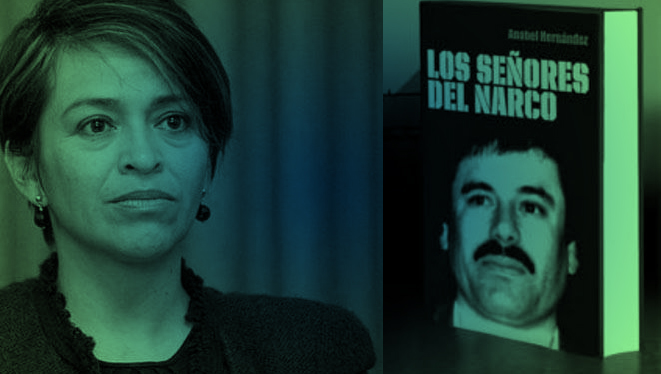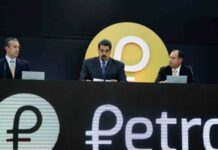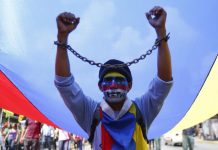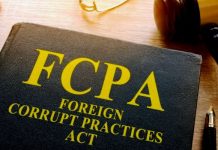
The author of The Lords of Narco had access to numerous legal records including testimonies from Mexican drug traffickers, one of which describes how Venezuelan military are in collusion with the Sinaloa cartel, to the point of guarding cocaine shipments leaving from the Maracaibo (Venezuela) airport towards Cancún (Mexico).
An exclusive interview with Anabel Hernánez by CuentasClarasDigital (CCD).
Anabel Hernández is a Mexican journalist and writer who dared to go beyond knowing the activities of drug cartels and the major drug kingpins in the country. She read numerous court and testimonies records and interviewed members of the Mexican organized crime to conduct an ambitious and deep investigation that allowed her to write The Lords of Narco (Los señores del narco), which reveals how the violent war among drug cartels in Mexico happened with the consent of the government, the police and the military and how this war is extending to other countries. As a result of her investigation, Hernández has received death threats, but she refuses to remain silent and, quite the opposite, she speaks passionately to firmly defend the lives of Mexicans.
CCD asked Hernández about the connections between the Mexican drug cartels and Venezuela; how these groups began to grow under the protection of different Institutional Revolutionary Party (PRI) administrations; and how in 2000, when everyone thought that the transition to a new administration would bring important changes, it only claimed to monopolize the cartel of Sinaloa, thus increasing the violence.
CCD also asked her about the decriminalization of drugs, which she adamantly opposes. «Legalization will not change drug trafficking. The only way to combat drug trafficking is taking away their money, a very difficult issue to deal with because it involves government officials, banks and business people”.
Venezuela and Ecuador— drug trafficking warehouses
— What connections have you found between the Mexican drug cartels and Venezuela?
— There are several court records, to which I had access. They are preliminary investigations conducted by the Attorney General of Mexico, which is responsible for investigating federal crimes related to drug trafficking. Those records include many testimonies of members of drug gangs who talk about many connections among drug cartels, but especially between the Sinaloa cartel and Venezuela.
— [In 2007] A plane loaded with drugs crashed in Mexico. The government of Mexico began to investigate where all that came from: the plane left from Venezuela. This is one of several criminal cases involving both the territory and the government of Venezuela. In his affidavit, drug dealer Sergio Villarreal Barragán, alias “El Grande”, extradited to the U.S., reveals how cocaine-laden planes left mainly from the Maracaibo airport. One of those planes landed in Cancun, and there its status as an international flight was changed to a domestic flight, thanks to the complicity of the airport authorities. That plane coming from Maracaibo ended up downloading cocaine at the Toluca International Airport, which is basically an airport receiving private and commercial flights. The plane was parked in the hangar of a company called Aerocondor.
Sergio Villarreal Barragán affirms that between 2007 and 2008 twenty six drug-laden planes entered Mexico. «He narrates how Venezuelan military colluded with the Sinaloa cartel. Venezuelan military where responsible for protecting the cocaine shipment, which could not be easily manipulated in Maracaibo; they also guarantee that the shipment was properly loaded in the aircraft and that the plane could take off safely. We are not talking about small but big planes”.
During her investigation, Hernández managed to interview several drug traffickers. “They told me that Venezuela and Ecuador are very important locations for drug trafficking. The cocaine comes from Peru and Bolivia and from there it is distributed all over the world via Venezuela or Ecuador. Venezuela and Ecuador are transit countries in the cocaine distribution chain”.
– When I read the affidavit of this drug dealer [Sergio Villarreal Barragán], I could understand the relationship between the FARC and the government of Hugo Chávez. Everyone knows that the FARC began as a revolutionary and ideological movement and that it ended up producing cocaine and appropriating lands where cocaine is produced. I am not surprised by the revelations stemming from these affidavits. They show, for example, that every time the planes came from Maracaibo to Cancun airport authorities were bribed. Every international flight is supposed to go through a strict customs inspection, but in these cases there was no customs control at all—none. It is also assumed that flights coming from Colombia, Venezuela or Peru must also be inspected by the canine brigade searching for drugs and other things. There was no canine inspection either. We are thus talking about a large chain of corruption between Venezuela and Mexico.
Breed crows and they’ll eat your eyes
Professionally speaking, life has not been easy for journalist Anabel Hernández. In addition to The Lords of Narco, she has published The Presidential Family: The Government of Change under suspicion of corruption on former Mexican president Vicente Fox (co-authored with Areli Quintero) and Mexico in Flame: Calderón’s legacy.
—In your opinion, despite all the military deployment in recent years, has the problem of drug trafficking in Mexico been minimized or has it worsened?
—Not only will this problem not be solved—it will also become more complicated.
—What did really happen?
—I’ll explain the government’s relationship with the drug cartels. The sudden violence that happened overnight is what put Mexico in flames. The investigation that I conducted for The Lords of Narco combined documents and testimonies, that is, I had access to court records in a country where common people do not have access to these kind of documents—you need someone to give them to you; you cannot even get them by means of the Transparency Act. My investigation is then based on court records and the testimonies of drug traffickers, military men and policemen from the 60s to date.
From 1960 to 2000, Hernández states categorically, the PRI administrations (the Institutional Revolutionary Party governed Mexico from 1929 to 2000, and returned to power on December 1st, 2012, with current president Enrique Peña Nieto) «negotiated with the drug cartels. The government granted them control over a particular piece of territory, allowing them to traffic and to do virtually anything they wanted, including smuggling drugs into the United States under the conditions that there was no violence and that the drug did not stay in Mexico”. According to information provided by active policemen at the time, shipments of marijuana and heroin were guarded by the police and military themselves to the border, making sure that the drug did not stay in Mexico.
– Of course, that agreement was based on corruption —Anabel Hernández explains—; there were bags full of money that drug traffickers pay as a kind of tax. For many years, the government controlled these criminal groups, which were small at the time; they were not the cartels that we see today in Mexico with large arms and large international connections. We’re talking about a group of farmers mainly in Sinaloa and Chihuahua, on whose land grows, as if it were God’s will, marijuana and poppy. They were engaged in drug trafficking but also yucca cassava bread and other items.
But in the 70s and early 80s, Hernández goes on, the dynamics of small criminal groups changed because they began to operate in connection with the Colombians. “Who connects them,” she wonders— it was the CIA, she responds. This is in fact one of the main findings of her book.
«At that time, there was the problem of the contras in Nicaragua (an armed movement created and funded by the United States to attack the Sandinista government of Nicaragua). The Reagan administration says: ‘we do not want a new Cuba in Central America, another focus of communist pollution.’ And that’s how the US created the Nicaraguan contras”.
– For a year – details —Hernández says— the U.S. Congress decided to fund with public money the Nicaraguan contras, which received money, medicine, and food. But that same Congress discovered that the Nicaraguan contras were smuggling arms to Iran (the Iran-contra scandal, also known as Irangate), one of the world powers that has historically been an enemy of the American empire. When that happened, the US cut the funding to the Nicaraguan contras. For Ronald Reagan, however, it was still important to prevent the focus of communist infection from spreading, and that’s why he sent the CIA to Colombia to negotiate with the Medellin Cartel so that it started trafficking into the United States. The Regan administration opened up the doors of airports in Florida and other states to allow the cocaine coming from Colombia to enter into the US without restrictions. There was only one condition: part of the profits should go to the Nicaraguan contras. In other words, the Nicaraguan contras ended up being financed by the Medellin cartel, along with the Honduran drug lord Juan Ramón Matta Ballesteros, who is currently serving time in the United States.
How did Mexico get involved in the financing of the Nicaraguan contras?
The Reagan Plan needed the Mexican platform to provide gas, do reporting and ship drugs through the routes already known. Mexican drug traffickers went from mid-size to very big and powerful organizations, thanks to cocaine money. One thing was the profits stemming from the trafficking of marijuana and heroin, and a very different thing was the big gains resulting from trafficking cocaine in connection with major criminal groups in Colombia. That completely changed the relationship between the government and the drug cartels in Mexico. Cartels began to devour the government. You know the saying, “breed crows and they’ll eat your eyes”. That was exactly what happened not only in Mexico but also in the United States because the U.S. government is co-responsible for the existence of those big criminal gangs that we see today in Mexico”.
The whole frame is described in documents from the U.S. Congress, where there were hearings and testimony from members of the military, narcos, and Pablo Escobar’s bookkeeper, who talked about all this. Mexican drug gangs began to grow protected by the PRI administrations.
The Fox government protects the Sinaloa Cartel
Hernández explains why the problem of drug trafficking worsened when Vicente Fox’s became president of Mexico in 2000.
—People thought that Fox’s would be a government of transition, but that never happened. All Mexican groups of power, both legal and illegal, remain untouchables, and in many cases they connect and get together to launder money. When Fox becomes president, he radically changes the rules of the game: instead of continue to protecting all drug cartels, as the PRI administrations did for decades, he decided to protect only one—the Sinaloa cartel. It was the government that released Chapo Guzmán (Joaquín Guzmán Loera ) from prison; he did not escaped in a laundry basket, as the official version says. The truth is, and I know it because I have a copy of the criminal record, that a public official working for Vicente Fox’s administration took Chapo Guzmán out of prison—he just opened the main gate and told him: ‘Sir, you’re good to go’”.
She describes her conversation with a Mexican General who was killed in 2012.
—Following orders from president Felipe Calderón (2006-2012), this General established direct contact with Chapo Guzman. Guzman himself ratified this story. He told the General: ‘Yes, I walked out the main gate”.
But in addition to the revelations made by this General, Anabel Hernández refers to another conversation she had with a DEA agent.
—I knew from DEA agents that the Sinaloa cartel had paid more than $ 20 million to Vicente Fox to take Chapo Guzmán out of prison. When asked about it, Chapo Guzmán just said: ‘General, freedom is priceless’. Once out of prison, the government started a police and military battle against the enemies of the Sinaloa cartel and its capo, Chapo Guzmán, allowing the latter to create a drug monopoly in Mexico.
The war between cartels won’t stop
But it was impossible for Vicente Fox to monopolize the drug market in Mexico.
—The problem is that the cartels, which started to be fought by the Mexican government, had occupied their territories for decades. They would not leave their business and say, ‘Sir, here I come to surrender’. No way. This is how a bloody drug war began in 2003. It was triggered by a bazooka shooting in Nuevo Laredo. The war between drug cartels will not stop. The Government of Mexico has not been an authority to combat drug trafficking because it sided with one cartel. It used all the means it had fighting other cartels. The government has not been really determined to end drug trafficking—it simply doesn’t care.
—Is the government of Enrique Peña Nieto supporting this situation?
—After almost a year in power, violence continues unabated. Extortion, missing people is still a reality in Mexico, and it is important to explain this. The Sinaloa and other drug cartels are now imposing their own candidates for state governors in Mexico. The Gulf cartel still controls the area of Tamaulipas and Veracruz, and they put and remove governors there. Quintana Roo and Yucatán remain areas of free transit because those are very important locations for the arrival of planes and boats loaded with drugs. The Sinaloa cartel still controls the airport.
—How many drug cartels are there in Mexico?
—At the beginning of Felipe Calderón’s administration there were the Tijuana cartel, the Sinaloa Federation, a group of different cartels led by Chapo Guzmán, the Gulf cartel, Los Zetas, the Familia Michoacana cartel and the Juárez cartel. These drug gangs are still active in Mexico today, but there are also some new players: Caballeros Templarios (Knights Templars), the New Generation cartel in Jalisco, and New People Cartel.
Legalizing drug?
Anabel Hernández who recognizes that she is no specialist in health or law, but speaks on her own experience, which includes conversations with drug dealers and reading hundreds of court records and reports from the DEA, warns that “if people think that the decriminalization of drugs will fight the cartels, then they are absolutely wrong. That’s a joke. Justify it otherwise, but do not say that’s why. «
– Drug cartels will always find a way to break the law; they will always find other ways to do their business. I went to Amsterdam last November, and as we all know the Netherlands has legalized marijuana. There are «coffee shops.” The weed that is consumed in very legal places has an illegal origin; it is smuggled to the Netherlands. The Dutch smoke a «joint” that will surely buy a bullet to kill a Mexican. Weed is sold in well-established places where taxes are paid, but they do not pay for the funeral of the Mexican who was killed with that bullet. This is a situation that the world does not quite understand; the world does not understand who these criminals really are and what they are capable of.
Hernández has the impression that legalizing drugs is a joke. «Now Vicente Fox, former president of Mexico, proposes the legalization of drugs, when he himself brags to be one of the biggest producers of marijuana; he even says that he is making changes in his ranch towards this goal. Why did not he propose the legalization of weed when he was still president? He could have changed the constitution. Why none of these former Latin American presidents who are now advocating for the legalization of drugs didn’t do it when they were in power? Why now? Why don’t they tell the truth?”
– Legalization will not change drug trafficking. The only way to fight drug trafficking is taking their money, fighting their business. When you talk directly with those guys (criminals, rapists, cruel murderers, very sick minded people) they say, “Lady, do not see us this way; this violence, this crime, the dismembered people—this is just collateral damage, we are businessmen. Violence is only collateral. I wish we could avoid it. Nobody wants to do these things, it does me no good, but this is the business”. A business that is worth billions of dollars.
Hernández argues that these criminals will not stop. In November 2013, the DEA published a report on new drugs that are being commercialized in the world, which reveals how the cartels have already fabricated a small synthetic pill that produces the same effect as weed. While some countries are now considering legalizing drugs, the cartels are producing more synthetic, more addictive, more dangerous and harmful drugs.
It is not true, the Mexican journalists contends, that the war on drugs has failed. «When Ronald Reagan was opening the doors of the American airports to the Medellin and the Mexican cartels, at that precise moment Nancy Reagan was doing a presentation in a school and saying, “Do not use drugs”. Do not use drugs, they say, but at the same time the American government was putting on the table the whole cartel for people to consume it. It is hypocritical, it is absurd that Ronald Reagan, who coined the phrase “war on drugs”, in fact opened the doors of the United States to the Mexican cartels, which is supported by documents of the U.S. Congress. The result was a terrible poisoning of the society .
The real «Lords» of Narco
While writing and researching for her book of The Lords of Narco, Anabel Hernández decided that she would not limited her book on writing about Chapo Guzmán and other drug criminals «because when you dig into their stories and all you find is misery, corruption, people who are not people—they are animals” Instead, she wanted to portray the real drug lords. “Readers of my book will discover that drug lords —the least important is Chapo Guzman— are in fact governors who protect drug traffickers, the president of the Republic who opens the door to their business, important businessmen and bankers who launder money stemming of the drug cartels and allow that money to enter the legal financial system.
There are investment banks that have been sanctioned for their activities favouring the drug cartels…
Hernández says that initially she was unsure about how the money from drug trafficking actually circulated.
— I then managed to talk to an important lawyer involved with these criminals, a lawyer of the Sinaloa cartel. I asked him how the money is moved, and his answer was, “Banks”. “How?” I said. “Do you have to bribe the manager?” “No, no”, he explained. “The manager cannot solve the problem of someone trying to launder twenty, one hundred million dollars. I meet with corporate boards in Mexico, with corporate directors to negotiate these things. This is how it works: let’s say that tomorrow you need to move money to Germany or London to pay for a drug shipment in Colombia. We go to different banks to explain what we need and what kind of operation we want to do. This way, banks charge fees that they will not report; these transactions are recorded separately, in accounting books that are handled in parallel and are sent to the Treasury Office. There, one bank says that it will charge 6 percent, another banks offers 5, another 3. The money goes to the bank that charges less in commissions. What they do is a collection of investments that end up being absolutely anonymous.
—Drug cartels, explains Hernández, also move their money through large companies that have the financial capacity to inject that money in the system without drawing attention. In Mexico, for example, they put the money in a mutual fund where everything gets diluted.
Anabel Hernández reminds us that there is a very complex investigation carried out by the DEA on a money laundering network of the Sinaloa cartel. Two businessmen, one Brazilian and one Portuguese, created a pyramidal scheme of fraudulent investment or Ponzi scheme, which included inexistent renewable energy plants with the sole purpose of transfering millions of dollars from different bank accounts. This is how they managed to shuffle money from financial fraud with money from drug trafficking thus practically made impossible to trace the origin and destination of that money.
The DEA has spent five years investigating this case, trying to unleash the skein, and the drug money has been finally found. Drug cartels have developed very sophisticated ways to launder money. And this cannot be destroyed with bullets or bombs, but with will. The banks involved in this investigation, for example, are Wachovia, Wells Fargo and Bank of America.
Final thoughts from the journalist
Anabel Hernández acknowledges that while Mexico is a hotbed of corruption and the government is responsible for what is happening, it is also true that other governments around the world that allow money laundering are co-responsible for the slaughter that is happening in Mexico and in many other places. She mentions as an example the cases of Guatemala and Honduras, where there are territories totally controlled by drug traffickers. And this reality, she contends, will spread. “Those who cannot not see it are simply blind,” she concludes.












